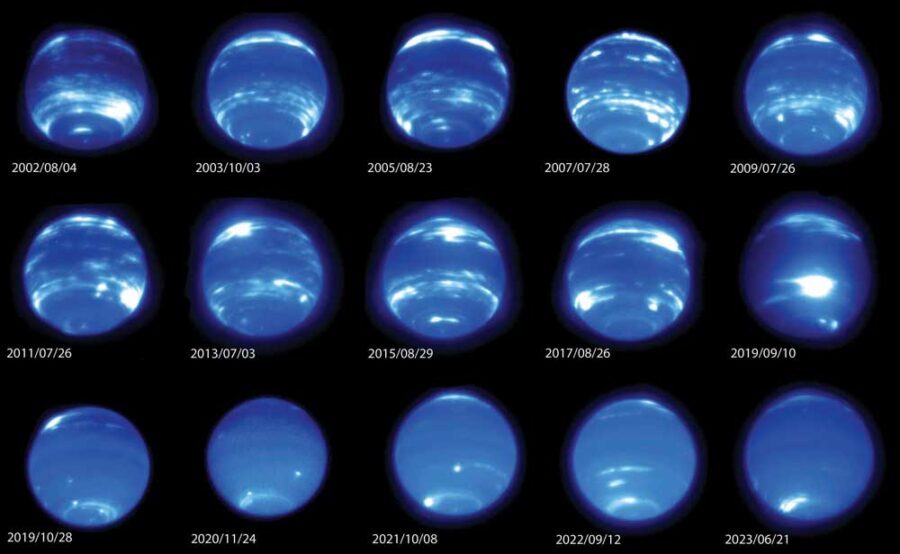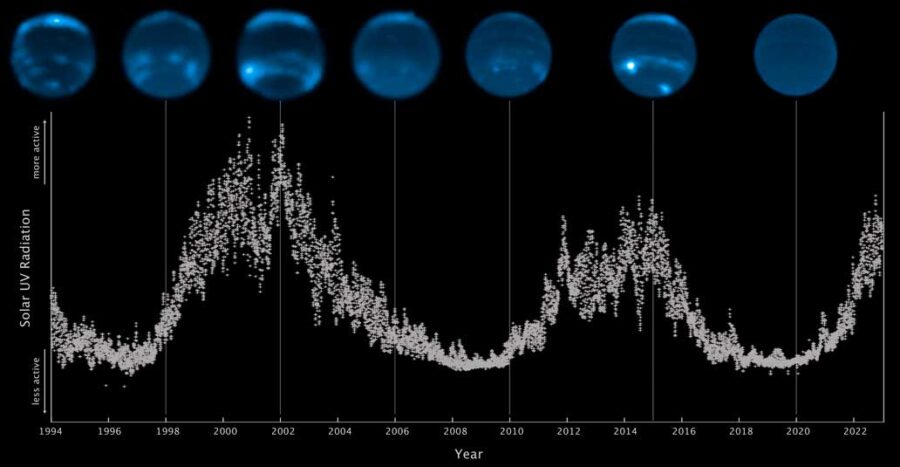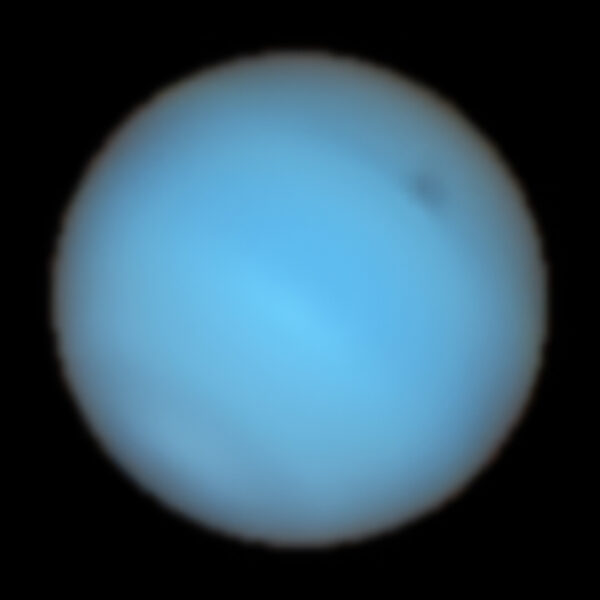Nearly 30 years of observations indicate that Neptune’s clouds and brightness vary with the Sun’s activity.
Deep in the cold reaches of our solar system, some 4.5 billion kilometers from the Sun, the ice giant Neptune is an unexpectedly happening place. Its atmosphere is chaotic, with clouds that rapidly appear and disappear and supersonic winds that blow faster than any in the solar system.
On its frosty orbital perch, Neptune receives only 0.1% as much sunlight as Earth does. Yet it appears that the Sun’s behavior can still influence the ice giant’s atmosphere.
Planetary scientists have suspected for decades that the solar cycle drives atmospheric activity on Neptune. Measurements from the 1970s through the 1990s suggested its brightness changed in ways that weren’t purely seasonal. Several studies found that the planet dimmed near solar maximum, when the Sun’s magnetic activity reaches its peak, and brightened near solar minimum.
Observations improved dramatically in the 1990s and 2000s with the launch of the Hubble Space Telescope and the advent of advanced imaging techniques for ground-based scopes. These developments enabled astronomers to actually see the detailed distribution of clouds on Neptune — something previously possible only during Voyager 2’s flyby in 1989.
But around this time, something changed. Neptune flipped its behavior, appearing bright during solar maximum instead of dim and vice versa. Scientists wondered whether the suspected connection had evaporated.

Imke de Pater, Erandi Chavez, Erin Redwing (UC Berkeley) / W. M. Keck Observatory
Last year, Michael Roman (University of Leicester, UK) and others looked at how mid-infrared emission from Neptune’s upper atmosphere changed from 2003 to 2020. Among their findings, they noticed that the number of clouds in the planet’s atmosphere might be tracking the solar cycle. The data covered less than two solar cycles, however, so it was hard to say.
Erandi Chavez (now Center for Astrophysics, Harvard & Smithsonian) and others have now found compelling evidence that not only does Neptune brighten soon after the Sun hits its max, but also that the change is due to an uptick in the number of bright, high-altitude clouds.
The researchers collected hundreds of archival near-infrared images taken by Hubble and the Keck and Lick observatories, creating a detailed sequence that reaches back to 1994. At these wavelengths, the clouds reflect sunlight, so the team could use the clouds’ brightness to measure how widespread clouds were, Chavez explains. The images reveal that Neptune was brightest (and therefore cloudiest) in 2002 and 2015 and dimmest in 2007 and 2020 — in fact, Neptune abruptly lost nearly all its clouds beginning in late 2019 and is only slowly recovering now.
The planet’s behavior tracks the 11-year solar cycle, albeit with a 2-year lag: Shortly after solar maximum, Neptune shines brightest; after solar minimum, it’s dimmest.

NASA / ESA / LASP / Erandi Chavez (UC Berkeley) / Imke de Pater (UC Berkeley)
This correlation may be tied to sunlight’s impact on the molecules in Neptune’s atmosphere, the authors suggest in an upcoming issue of Icarus. The Sun’s total output changes only 0.1% over the course of its magnetic cycle. But its ultraviolet output surges by 40%. Ultraviolet radiation is a powerful chemist: It can break up the abundant methane in Neptune’s skies, enabling various hydrocarbons to form. These molecules might later condense or serve as cloud seeds.
Clouds typically need something to condense onto, usually small, solid particles, explains Patrick Irwin (University of Oxford, UK), who was not involved with the study. On Earth, seeds can be things like sea salt, smoke particles, meteoroid dust . . . But on giant planets, where there’s no solid surface, it’s unclear what the cloud seeds are. Ultraviolet-made hydrocarbons might do the trick. “The trouble is, there are all sorts of competing effects,” he says. “The authors here have very sensibly left this fairly open-ended.” The more important point is the apparent correlation between clouds and the solar cycle.
“It is an excellent body of work,” says Heidi Hammel (AURA), who has spent her career studying Neptune and took many of the observations Chavez’s team analyzed. “What excited me about this recent work is the sheer volume of data they brought to the table. . . . One of the things I’ve always enjoyed about studying Neptune is that it never looks the same. And this study is helping us better understand why that is.”
But correlations are tricky things, warns Roman, who is a coauthor on the new study. “The apparent change in the late ‘90s is what fascinates me most,” he says. It remains unclear why the relationship between the planet’s brightness and the solar cycle would have flipped on its head. “It could be that seasonal changes or meteorological events are altering conditions and changing how the atmosphere responds to solar variation, but we can only speculate.”
Seasons on the ice giant last 40 years, so teasing out the myriad factors influencing the atmosphere won’t happen quickly. “I’ve been studying Neptune my whole career, but that span from 1985 to today — 38 years — is still only the Neptune equivalent of less than three months,” Hammel says. “With outer planets like Neptune and Uranus, you have to play the long game and know that you are always laying the groundwork for the next generation.”

ESO / P. Irwin et al.
These bright clouds float fairly high in the atmosphere. Deeper down, other clouds appear that may be more impervious to solar fluctuations.
For example, a paper headed up by Irwin in Nature Astronomy this week reports spectral observations of a dark spot in Neptune’s atmosphere, in what the team thinks is a layer of photochemical haze and hydrogen-sulfide ice. The spectra confirm that it’s actually a dark vortex, not a clearing in the haze. It’s also accompanied by a bright spot like nothing astronomers have seen on the ice giant before — usually, dark spots come with bright but higher-altitude methane clouds. These deep clouds likely form through a completely different process than the ones in Chavez’s study, Irwin says.
References:
E. Chavez et al. “Evolution of Neptune at Near-Infrared Wavelengths from 1994 through 2022.” Icarus. November 2023.
P. G. J. Irwin et al. “Spectral Determination of the Colour and Vertical Structure of Dark Spots in Neptune’s Atmosphere.” Nature Astronomy. Published online August 24, 2023.
*Update: The original article stated incorrectly that astronomers could not see individual clouds on Neptune before the 1990s, except during the Voyager 2 flyby — they could see individual clouds, but they couldn't see smaller clouds or the detailed distribution.
 4
4









Comments
Lou
August 24, 2023 at 6:04 pm
I thought this was the most interesting news I have ever read about Neptune when I read the article on Hubblesite yesterday, but the extra details here is next-level! Amazed that clouds could be observed pre-1990s (The New Astronomy textbook from 1983 doesn't even mention Neptune - the most distant planet shown is a very smeary near-IR image of Saturn from AAT).
You must be logged in to post a comment.
Andrew James
August 24, 2023 at 7:55 pm
I thought I knew much about astronomy and related subjects, but I haven't seen this quoted anywhere. Where is the source of this statement?
If this were true the consequences for life on earth would be dire. (If true, I'd be worried about going to the beach if one of these events occurred whilst the skin was exposed to UV.) My understanding is access ultraviolet light burst usually comes from flares emanating from the Sun as coronal jets. I read this 2021 article by Nóbrega-Siverio, et al. "Solar surges related to UV bursts: Characterization through k-means, inversions, and density diagnostics." First off. They say: "Surges are cool and dense ejections typically observed in chromospheric lines and closely related to other solar phenomena such as UV bursts or coronal jets. Even though surges have been observed for decades now, questions regarding their fundamental physical properties such as temperature and density, as well as their impact on upper layers of the solar atmosphere remain open."
Given the distance of Neptune from the sun, one would expect that the chances of one of these events striking the atmosphere of Neptune would be unlikely. Examining the solar data and the sky position of Neptune could predict if any event has interacted with the atmosphere of Neptune. I'm not entirely convinced that the course of the atmospheric anomalies seen in Neptune's atmosphere is caused by the Sun and is all just a coincidence. As said in the paper above: "Despite this observational and theoretical effort, important questions concerning surges remain open."
You must be logged in to post a comment.
Anthony-Mallama
August 25, 2023 at 8:24 am
This article about Neptune reports on important professional research at infrared wavelengths. S&T readers may be interested to know that visible light observations by amateur astronomers have yielded similar results.
Richard Schmude and other backyard observers recorded brightness variations of Neptune over decades-long timescales as reported in this paper of 2016, https://arxiv.org/ftp/arxiv/papers/1604/1604.00518.pdf. Evidence for the relationship between luminosity and methane clouds was also discussed there.
These results for Neptune as well as the luminosity of all eight planets in our Solar System were published in a peer-reviewed article in the journal Icarus the same year. That paper can also be viewed here, https://arxiv.org/abs/1609.05048.
The equations in the Icarus paper were adapted for use by the US Naval Observatory in computing planetary magnitudes in the Astronomical Almanac and by NASA/JPL in their online Horizons ephemeris. The article describing that work was published in Astronomy and Computing and it can also be seen here, https://arxiv.org/abs/1808.01973.
These findings attest to the importance of research conducted by amateur astronomers. Accurate observations and careful analysis often yield significant scientific results.
You must be logged in to post a comment.
rocketMike
August 28, 2023 at 12:17 am
Very interesting article.
Does anyone else see the large composite MUSE image as an optical illusion? No matter how long I look at it, it appears that Neptune is shrinking! Yet it never changes size!
You must be logged in to post a comment.
You must be logged in to post a comment.